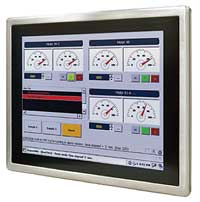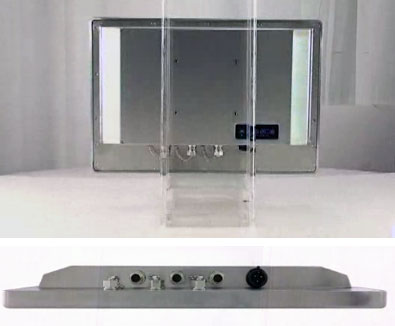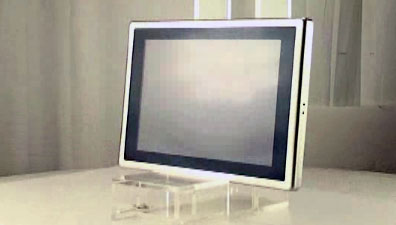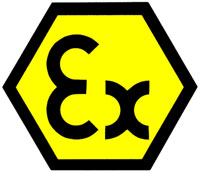|
Winmate Stainless Panel PC
ATEX-certified fanless stainless steel panel PC suitable for hazardous area deployment
(by Conrad H. Blickenstorfer)
Winmate is a Taiwanese company founded in 1994. Specializing in industrial display technologies and solutions, Winmate also branched out into Tablet PCs, digital signage, rugged Mobile PCs, embedded automation controllers, marine grade displays and computers, and Panel PCs such as the Stainless Panel PC shown here.
 Panel PCs are a special kind of all-in-one PCs used for a variety of situation where computing power is needed, but there's no need or room for a conventional desktop or laptop. Panel PCs are a special kind of all-in-one PCs used for a variety of situation where computing power is needed, but there's no need or room for a conventional desktop or laptop.
Panel PCs often run custom software that's optimized for touch and designed for one specific task. Winmate's stainless steel Panel PCs are further specialized in that they are designed for use in hazardous areas.
For a description of hazardous areas and the various classification systems used to describe them, see column to the right.
The Winmate Stainless Panel PC
Winmate designed their line of Stainless Panel PC in response to requests for Panel PC equipment suitable for deployment in certain hazardous locations where flammable substances may be present. Specifically, the panel is certified for use in Class 1, Division 2, Groups A through D (i.e. Acetylene, Hydrogen, Ethylene, and Propane) classified areas and surface temperatures not exceeding 275° Fahrenheit (135° Celsius) in the US market, and ATEX Gas Zone 2 classified areas in European and other markets.
The fanless 15-inch Stainless Panel PC has a footprint of 15.6 x 12.2 inches and is less than two inches thick. The sturdy stainless steel housing has anti-corrosion protection and carries an IP65/NEMA4 sealing rating, meaning that it's completely protected against dust, and also protected against low-pressure water jets from all directions. The very wide -4 to 140 degree Fahrenheit operating temperature range means the panel can be deployed almost anywhere.
As far as technology goes, offers both Intel Atom-based versions and Intel 3rd generation Core processor-based versions. RuggedPCReview.com analyzed the former, which is powered by a 1.6GHz dual-core Atom N2600 processor, working in conjunction with the Intel NM10 chipset. The device has a single memory slot that can accommodate a maximum of 4GB of DDR3 SO-DIMM 1333MHz RAM memory. Mass storage is generally via mini PCIe-based SATA III Solid State Disk with capacities up to 256GB. Hard disks can be used as well if larger storage capacities are needed.
The display measures 15 inches diagonally and uses the 4:3 aspect ratio with 1024 x 768 pixel resolution. Backlight brightness is 400 nits, i.e. about twice as bright as a consumer notebook. Horizontal viewing angle is 160 degrees, vertical viewing angle 140 degrees, both par for this type of panel. There are no hardware directional or function buttons or controls; all operation is via screen touch. The panel comes standard with ELO 5-wire resistive touch technology, most likely ELO's AccuTouch (see here). Depending on the application, customers may also consider optional projected capacitive touch.

Onboard connectivity is limited as panels are usually installed and dedicated to one special task, as opposed to mobile devices that may need to connect to a wealth of devices and peripherals. So the Stainless Panel PC has an RJ45 LAN port, a legacy RS232 (or optional RD422/485) serial port, a dual USB 2.0 receptacle and a power jack for its 12 Volt DC operating current. All ports are in the back of the panel, facing downward.
Expansion is available via a mini PCIe slot. There aren't any other external or internal card slots. Winmate mentions that PCI expansion is available, but it requires a customized housing with a deeper profile than the stock panel's svelte two inches.

Apart from its inherent ruggedness and certification for use in certain types of hazardous locations, the Winmate Stainless Panel PC (model# R15ID3S-65FTE) is also an eyecatching and exceedingly elegant design with its sleek glass face and gleaming stainless steel bezel/housing.
Contact Winmate:
Web: www.winmate.com.tw
Email: sales1 @ winmate.com.tw
OEM/ODM Contact: ODM@winmate.com.tw
|
|
|
|
Specifications Winmate Stainless Panel PC
|
|
Added/changed
|
Added 09/2013
|
|
Form-factor
|
Stainless Steel Panel PC
|
|
OS
|
Windows 7 Embedded, optional Windows XP Embedded
|
|
Processor
|
Intel Atom N2600
|
CPU Speed
|
1.6GHz
|
|
Chipset
|
Intel NM10
|
Standard/Max RAM
|
1GB to 4GB DDR3 in one SODIMM slot
|
Disk/drive
|
32GB to 256GB SSD (mini-PCIe) or SATA III HD
|
Card slots
|
2 x mini-PCIe
|
Display type
|
TFT, 400 nits backlight
|
Display size/res
|
15.0-inch XGA (1024 x 768) pixel
|
Digitizer/pens
|
Either ELO 5-wire resistive touch or optional projected capacitive touch
|
Keyboard/scale
|
Optional external USB keyboard
|
Operating temperature
|
-4° to 140°F (-20° to 60°C)
|
Sealing
|
IP65
|
Vibration
|
unknown
|
Humidity
|
30-90% non-condensing
|
Vibration
|
Operating: 5 Hz ~ 500 Hz/ 1 Grms/ 3 Axis Packing:: 5 Hz ~ 500 Hz/ 2.16 Grms/ 3 Axis
|
Shock
|
Operating:15G, 11ms duration
|
Housing
|
Stainless steel chassis
|
HazLoc NEC (US)
|
Class 1; Division 2; Groups A, B, C, D; T4
|
HazLoc ATEX (Europe)
|
II 3 G Ex nA ic IIC T4
|
Test reports
|
IEC 60079-11 (Intrinsic safety "i", IEC 60079-15 (Equipment protection type "n")
|
Size (WxHxD)
|
15.6 x 12.2 x 1.93 inches (396 x 310 x 49 mm)
|
Weight
|
NA
|
Power
|
12V DC (lockable power jack)
|
Interface
|
2 x USB 2.0, 1 x RJ45 10/100, 1 x RS232 (optional RS422/485)
|
Wireless
|
optional wireless mini-PCIe
|
List price
|
Inquire
|
Web
|
Winmate Stainless Panel PC
|
Data sheet
|
 Stainless Panel PC spec sheet Stainless Panel PC spec sheet
|
|
|
What are "Hazardous Locations"?
|
|
The term "hazardous location"—or "HazLoc"—originates from electrical engineering where a hazardous location is defined as a place where concentrations of flammable gases, vapors, or dusts occur. Electrical equipment operating in such areas must be designed so that they do not cause combustion or explosions. Devices that fulfill that requirement are described as "intrinsically safe," which means that they are incapable of igniting such gasses, dust or vapors.
As one might expect, there are degrees of intrinsic safety, and there are many different classification systems for various hazardous substances, as well as for the degree of the presence of such substances.
For the classification of rugged computing equipment, manufacturers generally use either the North American National Electric Code (NEC) or the European ATEX directive, or both. ATEX stems from a French expression that includes ATmospheres EXplosives. How do those two entities classify hazardous environments?
NEC first differentiates between
- Class 1 (Flammable gases)
- Class 2 (Flammable dust)
- Class 3 (Flammable fibers)
Each of the classes then is either
- Division 1 (substance present all the time), or
- Division 2 (substance present only for brief time).
A third level (Group) then describes the specific type of gas, dust or fibers.
IEC/ATEX, on the other hand, first differentiates between:
- Flammable gases and vapors ("G"), and
- Flammable dust ("D").
Flammable gases are then assigned:
- Zone 0 (always present)
- Zone 1 (likely present), and
- Zone 2 (occasionally present).
Flammable dust uses
- Zone 20 (always present)
- Zone 21 (likely present), and
- Zone 22 (occasionally present).
Each zone then requires equipment built for
- Category I (present continuously)
- Category II (present intermittently), and
- Category III (occasionally present).
To illustrate how these classification systems apply to real life situations, picture a gas station.
Using the NEC classification, underground gas tanks and tanker truck tanks are Class 1, Division 1; the area around a tanker truck or a gas pump would also be Class 1, Division 1; and the general gas station area is Class 1, Division 2.
Using the IEC/ATEX classification, underground gas tanks and tanker truck tanks are Zone 0, Category I; the area around a tanker truck or a gas pump would be Zone 1, Category I; and the general gas station area is Zone 2, Category 2.
Note that this is an oversimplification; both standards have several additional classification criteria such as temperature, explosion groups, protection levels, etc. (for additional info, check out this classification reference guide).

|
|





